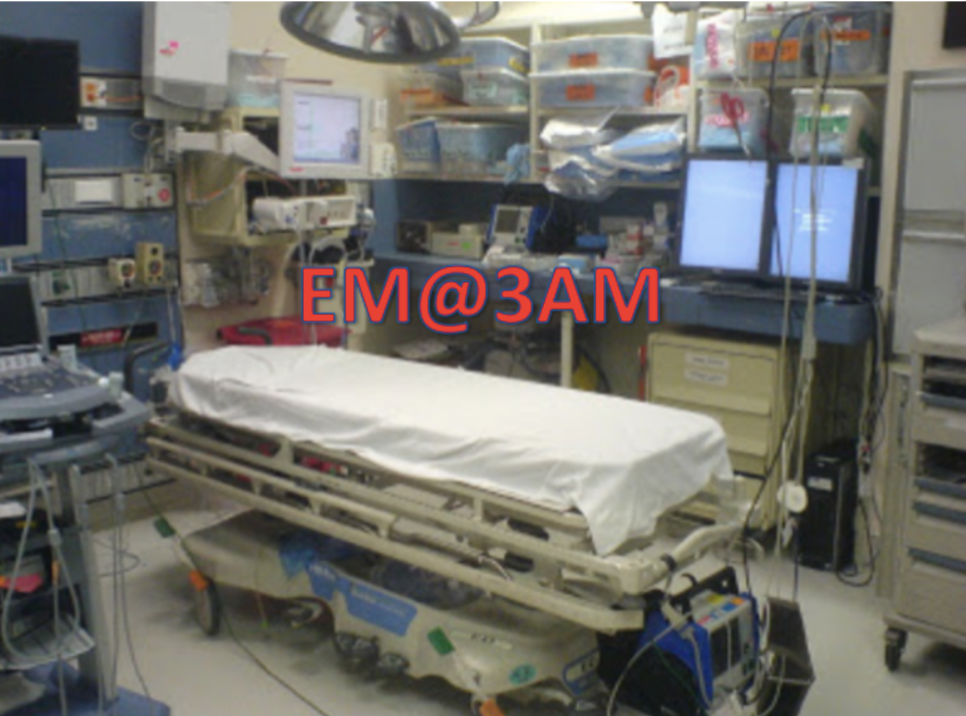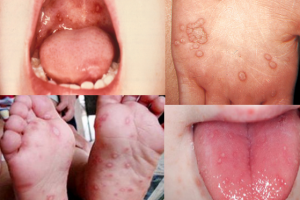Welcome to EM@3AM, an emDOCs series designed to foster your working knowledge by providing an expedited review of clinical basics. We’ll keep it short, while you keep that EM brain sharp.
A 70-year-old male with hypertension (HTN) presents with 5 days of fever and 3 days of anuria and malaise. He also notes worsening abdominal distention and shortness of breath. He found and removed a tick 3 weeks ago and another one 1 week ago. He denies cough, rhinorrhea, nausea, vomiting, diarrhea, recent travel, or sick contacts. He denies ETOH, tobacco, or drug use.
Triage vital signs: BP 82/50 mmHg, HR 113 bpm, RR 20 breaths/min, SPO2 87% on RA, T 37.3 C
Exam: HEENT unremarkable. Cardiac exam reveals tachycardia with no murmurs, rubs, or gallops. Lungs are clear bilaterally to auscultation. Abdomen is distended, non-tender, with no palpable fluid wave. Extremities have 2+ pulses with good capillary refill. The patient is neuro intact.
Point-of-care ultrasound (POCUS) revealed no ascites, mildly atrophic kidneys, no hydronephrosis, and inability to visualize the bladder.
Labs reveal WBC 2,200 cells/microL, HGB 11.2 g/dL, Plt 21 × 109/L, BUN 86 mg/dL, Creatinine 6.8 mg/dL, AST 350 U/L, ALT 119 U/L.
What is the diagnosis?
Answer: Ehrlichiosis
Background:
- Ehrlichia chaffeensis was first identified as a human pathogen in Arkansas in 1986.1
- Ehrlichiosis has seen a six-fold national increase in incidence over the past 20 years.2
- Likely a combination of increased transmission in addition to increased awareness and testing, resulting in earlier identification.
Etiology:
- Ehrlichia chaffeensis, Ehrlichia canis, and Ehrlichia muris infect monocytes and macrophages and are the main cause of Human Monocytic Ehrlichiosis (HME).1
- As an intracellular pathogen, it replicates in host vacuoles and forms microcolonies called morulae that can be visualized under light microscopy.3
- Human Granulocytic Ehrlichiosis (HGE) is caused by Anaplasma phagocytophilum and is also referred to as anaplasmosis or Human Granulocytic Anaplasmosis (HGA).1
- Carried primarily by the lone star tick, white tail deer are the main reservoir
- Geographic distribution is throughout the southeast and south-central United States, but cases are gradually appearing more frequently further north.
- Severe presentations are likely secondary to dysregulated CD8 T cell response, similar to toxic shock.3
- Impacts most organ systems. Pathology findings in cases of fatal ehrlichiosis include:3
- Cholestasis
- Focal hepatocellular necrosis, hepatic granulomas
- Lymphohistiocytic infiltrates in kidney, heart, liver, meninges, brain
- Mononuclear phagocyte hyperplasia of spleen, liver, lymph nodes, bone marrow
- Pneumonitis
Epidemiology:
- The national average incidence is estimated at 0.7 cases/million people.3
- The true incidence is likely higher as up to two-thirds of patients can have very mild symptoms or even be asymptomatic.
- With active surveillance in endemic areas, rates of ehrlichiosis were noted to be up to 1–2 cases per 1,000.
- 57% of cases where patients sought medical care between 2008-2012 required hospitalization, 11% with life-threatening complications.1,4
- Case fatality rate 1-3%;1,4
- 14% in children < 5 years
- 53% in adults > 70 years
- Co-infections are possible, but not well documented specifically for ehrlichiosis.
- Ticks are known to carry multiple diseases, consider co-infection if not improving as expected or if multiple ticks are found.5
- There have been case reports of co-infection with Rocky Mountain Spotted Fever (RMSF) as these infections share a geographic region.6
- Patients with Lyme often are coinfected with babesiosis and/or anaplasmosis.7
- Vector overlap:3,8
- Lone Star Tick: Tularemia
- American/brown dog tick: RMSF, Tularemia
- Ticks that cause ehrlichiosis can also cause tick paralysis.3,8,9
- Ticks are known to carry multiple diseases, consider co-infection if not improving as expected or if multiple ticks are found.5
Figure 1. Overlapping geographic distributions of tickborne illnesses. Source: Centers for Disease Control and Prevention (CDC). Reported Cases of Tickborne Diseases – 2019-2022. Accessed April 30, 2025. https://www.cdc.gov/ticks/media/images/2024/06/TBD-Consolidated-Map_Static_6.21.24.JPG

Figure 2. Geographic domains of various tickborne illnesses. Source: Centers for Disease Control and Prevention (CDC). Emerging Tickborne Diseases.; 2017. Accessed April 30, 2025. https://cdn.mdedge.com/files/s3fs-public/Image/June-2017/eickhoff_tickbornediseasesinusa_f1.jpg

Clinical Presentation:
- Vague febrile illness starting 1-2 weeks after an infected tick bite.1
- Most cases are self-limited, and many infected with chaffeensis are asymptomatic.3
- Common symptoms:3
- Fever
- Malaise/myalgias/fatigue
- Headache
- Shortness of breath
- Nausea/vomiting/diarrhea
- Abdominal pain
- Non-specific petechial rash (more common in kids)
- If left untreated, can progress to involve the central nervous system (CNS) and peripheral nervous system (PNS):2
- Ataxia
- Cranial nerve deficits
- Encephalopathy
- Meningitis
- Plexopathies and polyneuropathies
- Seizures
- Rash may be present in up to 10% of patients and usually spares the palms and soles (unlike RMSF). Pattern may consist of:3
- Erythroderma
- Maculopapular pattern
- Petechial pattern
- Uncommon symptoms with ehrlichiosis that should raise concern for other tickborne diseases:10
- Mono or oligoarthritis – Lyme
- Targetoid rash/erythema migrans – Lyme
- Rash on palms/soles – RMSF
- Severe presentations include septic shock, acute respiratory failure, renal failure, and multiorgan failure.1
- Increased severity and mortality in the elderly, children, and immunocompromised patients.
Table 1. Comparison of tickborne diseases, including their epidemiology, affected cell types, clinical history, key findings, and morbidity/mortality.3,4,8


Evaluation:
- Inquire about exposure risk (outdoor recreation, travel to endemic areas), family members with similar symptoms, and any tick bites or bumps/rashes.
- Only about 72% of patients remembered a tick bite, so keep this on your differential in endemic areas.1
- Perform a thorough head-to-toe exam as ehrlichiosis can affect every organ system.3,15
- General – Fever (97%), lethargy
- Cardiac – Shock, tachycardia, hypotension
- Lungs – ARDS, shortness of breath, cough
- Abdomen – Diffuse pain, nausea/vomiting/diarrhea
- Has been reported to mimic appendicitis
- Severe cases can develop cholestasis
- Neuro – Altered mental status, seizures, coma, cranial nerve palsy (CNS involvement 20%)
- MSK – generalized myalgias
- Skin – Retained tick, non-specific (petechial) rash/skin eruption (up to 66% in pediatrics, 10-21% adults)
- Palms and soles -> think RMSF
- Erythema migrans/target lesions -> think Lyme
- Remove any ticks to prevent further bacterial transfer and possibility of tick paralysis.
Diagnosis:
- A formal diagnosis is often made later in the clinical course, as presenting symptoms are vague and not all patients remember a tick bite.
- Treat empirically while waiting for confirmatory testing results, as delays in treatment are associated with worse outcomes.2
- Labs: Thrombocytopenia, leukopenia, transaminitis, and renal failure are all common findings and should increase suspicion for ehrlichiosis.1
- Definitive diagnostic testing:
- Polymerase chain reaction (PCR) testing is most sensitive in the first week of illness, and sensitivity decreases within 48 hours of doxycycline initiation.16,17
- The reference standard is serologic testing for IgG antibodies with paired acute and convalescent samples 2-10 weeks apart showing a four-fold increase in titer.16,17
- Lumbar puncture is not specific.3
- CSF pleocytosis in approximately 60% of cases.
- Mostly lymphocytic, but can be neutrophilic or mixed in one-third of cases.
- CSF WBC count is usually <100 cells/μL.
- CSF pleocytosis in approximately 60% of cases.
- Rare to actually see morulae on peripheral blood smear or in CSF WBCs.3
- Radiographic imaging may show leptomeningeal enhancement if there is CNS involvement.3
- EEG may show nonspecific slowing.3
Treatment:8
- Do not delay treatment while waiting for test results.
- First-line antibiotic therapy is doxycycline 100mg BID for adults or 2.2 mg/kg/dose BID in children, for a minimum of 3-5 days after fever resolves.
- Fever usually resolves in 48 hours.
- Most patients are treated with a 5-7 day course (at minimum).
- No alternative is recommended, and other antibiotic regimens have shown increased mortality.18
- Doxycycline does not have the risks of teratogenicity and tooth discoloration seen in other older tetracyclines.
- Up to 13% of patients with Lyme disease will also be infected with ehrlichiosis.19
- The doxycycline regimen used to treat Lyme disease will cover both diseases.
- Note that anaplasmosis is also treated with doxycycline 100 mg BID, but for a longer course of 10-14 days to cover for any coinfection with Lyme disease (since the rate of coinfection is high).8,20
- Antibiotic prophylaxis after a tick bite in general is not 8
- Unless there is a high risk for concomitant Lyme disease based on geographic location and the tick has been on for less than 72 hours – in that situation, 200 mg of doxycycline X 1 dose is recommended.7
Prognosis:16
- Overall, ehrlichiosis has a favorable prognosis with most cases being mild, self-limiting, and even asymptomatic.
- Approximately 57% of patients seeking care will require hospitalization.4
- Approximately 11-30% of hospitalized patients will require ICU care.
- Delay in diagnosis and treatment increases the risk for ICU admission.
- Severe complications are more likely with extremes of age, with the highest fatality rate in those > 70 years old.
- Immunosuppression may actually be protective against requiring ICU care, as most severe complications are caused by a dysregulated and overactive immune response.
- Most frequent ICU indications:
- Hypotension (77%), 79% of those requiring vasopressors
- Need for mechanical ventilation (40%)
- Secondary hemophagocytic lymphohistiocytosis (7%)
- Patients more likely to ultimately require ICU-level care have:
- Symptoms: Shortness of breath, altered mentation, seizures.
- Lab findings: AKI, thrombocytopenia, elevated AST, and elevated bilirubin.
- Most patients with ehrlichiosis respond well within 48 hours of doxycycline initiation.
Pearls:
- Ehrlichiosis is a rare multisystem tickborne illness with a rising incidence.
- The typical geographic distribution is the Southeast, Midwest, and New England.
- Symptoms may be non-specific (i.e. flu-like), but leukopenia, thrombocytopenia, transaminitis, and neurologic symptoms should raise concern for ehrlichiosis.
- Diagnostic testing involves PCR, serology, and exclusion of other infections.
- No antibiotic prophylaxis for ehrlichiosis is recommended after tick bites (unless bites occur in regions where Lyme disease is common).
- Treatment is doxycycline.
- Be on the lookout for possible coinfections with other tickborne illnesses.

A 45-year-old outdoor enthusiast presents to the emergency department with fever, headache, myalgias, and malaise. On physical examination, he is febrile with a temperature of 102.5°F (39.2°C) and demonstrates mild splenomegaly. No rash is identified. Laboratory findings reveal leukopenia, thrombocytopenia, and elevated liver transaminases. Which of the following is the most likely vector of disease transmission for this patient’s most likely diagnosis?
A) Blackfly
B) Cat flea
C) Lone Star tick
D) Mosquito
E) Triatomine bug
Correct answer: C
This patient is presenting with signs, symptoms, and laboratory findings that are consistent with human monocytic ehrlichiosis (HME) and human granulocytic anaplasmosis (HGA), caused by the bacteria Ehrlichia chaffeensis and Anaplasma phagocytophilum, respectively. Differentiation between the two illnesses is challenging without further diagnostic testing that can take weeks to complete. However, differentiation between the two diseases is not necessary to begin treatment.
Ehrlichiosis and anaplasmosis present with a constellation of symptoms that includes fever, headache, malaise, myalgias, stiff neck, andmental status changes. A rash can be present and is more often found in those with ehrlichiosis, although a rash still only occurs in one-third of patients. It is important to know the vector that carries this disease so the clinician can anticipate when to suspect such illness when working in endemic areas. These diseases are endemic in southeastern, south central and the mid-Atlantic regions. The principal vectors are the Lone Star tick, which transmits E. chaffeensis, and the black-legged tick, which transmits A. phagocytophilum. However, other tick vectors have also been found to have both organisms. Treatment for both diseases is with doxycycline.

The blackfly (A) is the vector for transmission of the parasite that is responsible for onchocerciasis. Humans are infected with the nematode larvae, Onchocerca volvulus, via the bite of the blackfly. After several months, the larvae grow into adult worms and the females begin to release microfilariae, which migrate through the subcutaneous tissue. The infection leads to ocular and dermatologic problems. Onchocerciasis is a major cause of blindness called river blindness in endemic areas.
The cat flea (B) is the most common flea found in the United States. Fleas are vectors for plague and murine typhus. Plague is caused by Yersinia pestis and leads to symptoms of headache, fever, chills, and swollen lymph nodes. Patients can also develop respiratory symptoms. Murine typhus is caused by Rickettsia typhi and leads to headache, myalgias, fever, and an erythematous papular rash that generally starts centrally and spreads outward.
Mosquitos (D) are the vector for transmission of a multitude of organisms and diseases including malaria, dengue, West Nile virus, yellow fever, Zika fever, and Japanese encephalitis to name a few. Mosquitos are the vector that carries the largest number of lethal diseases worldwide and care should be taken to protect oneself from mosquito bites. They do not carry the organism responsible for ehrlichiosis.
The triatomine bug (E) is the vector for transmission of the parasite that is responsible for Chagas disease. Trypanosoma cruzi is present in the feces of the triatomine bug. During a blood meal, the triatomine bug defecates on the skin of the host allowing the organism to enter through the bite wound. The major manifestations of Chagas disease are cardiomyopathy and gastrointestinal disease.
Further Reading
Further FOAMed:
- https://www.emdocs.net/r-e-b-e-l-em-emerging-tick-borne-illnesses-not-just-lyme-disease-part-4-rmsf/
- https://www.emdocs.net/lyme-disease-ed-presentations-management-pearls-pitfalls/
- https://www.emdocs.net/em3am-leukopenia/
References:
- Gygax L, Schudel S, Kositz C, Kuenzli E, Neumayr A. Human monocytotropic ehrlichiosis—A systematic review and analysis of the literature. Guo WP, ed. PLoS Negl Trop Dis. 2024;18(8):e0012377. doi:10.1371/journal.pntd.0012377
- Iyamu O, Ciccone EJ, Schulz A, et al. Neurological manifestations of ehrlichiosis among a cohort of patients: prevalence and clinical symptoms. BMC Infect Dis. 2024;24(1):701. doi:10.1186/s12879-024-09607-3
- Ismail N, Bloch KC, McBride JW. Human Ehrlichiosis and Anaplasmosis. Clin Lab Med. 2010;30(1):261-292. doi:10.1016/j.cll.2009.10.004
- Nichols Heitman K, Dahlgren FS, Drexler NA, Massung RF, Behravesh CB. Increasing Incidence of Ehrlichiosis in the United States: A Summary of National Surveillance of Ehrlichia chaffeensis and Ehrlichia ewingii Infections in the United States, 2008-2012. Am J Trop Med Hyg. 2016;94(1):52-60. doi:10.4269/ajtmh.15-0540
- Rocha SC, Velásquez CV, Aquib A, Al-Nazal A, Parveen N. Transmission Cycle of Tick-Borne Infections and Co-Infections, Animal Models and Diseases. Pathog Basel Switz. 2022;11(11):1309. doi:10.3390/pathogens11111309
- Sexton DJ, Corey GR, Carpenter C, et al. Dual infection with Ehrlichia chaffeensis and a spotted fever group rickettsia: a case report. Emerg Infect Dis. 1998;4(2):311-316. doi:10.3201/eid0402.980222
- Hu LT. Lyme Disease. Ann Intern Med. 2016;164(9):ITC65-ITC80. doi:10.7326/AITC201605030
- Centers for Disease Control and Prevention (CDC). Tickborne Diseases of the United States: A Reference Manual for Healthcare Providers, Sixth Edition, 2022.; 2022. Accessed April 30, 2025. https://www.cdc.gov/ticks/hcp/data-research/tickborne-disease-reference-guide/?CDC_AAref_Val=https://www.cdc.gov/ticks/tickbornediseases/index.html#print
- Diaz JH. A 60-year meta-analysis of tick paralysis in the United States: a predictable, preventable, and often misdiagnosed poisoning. J Med Toxicol Off J Am Coll Med Toxicol. 2010;6(1):15-21. doi:10.1007/s13181-010-0028-3
- Biggs H, Behravesh CB, Bradley KK et al. Diagnosis and Management of Tickborne Rickettsial Diseases: Rocky Mountain Spotted Fever and Other Spotted Fever Group Rickettsioses, Ehrlichioses, and Anaplasmosis — United States: A Practical Guide for Health Care and Public Health Professionals. Centers for Disease Control and Prevention; 2016. Accessed October 15, 2024. https://www.cdc.gov/mmwr/volumes/65/rr/rr6502a1.htm#surveillanceandreporting
- Lobo CA, Singh M, Rodriguez M. Human babesiosis: recent advances and future challenges. Curr Opin Hematol. 2020;27(6):399-405. doi:10.1097/MOH.0000000000000606
- Coburn J, Garcia B, Hu LT, et al. Lyme Disease Pathogenesis. Curr Issues Mol Biol. 2021;42:473-518. doi:10.21775/cimb.042.473
- Borawski K, Pancewicz S, Czupryna P, Zajkowska J, Moniuszko-Malinowska A. Tick paralysis. Przegl Epidemiol. 2018;72(1):17-24.
- Yeni DK, Büyük F, Ashraf A, Shah MSUD. Tularemia: a re-emerging tick-borne infectious disease. Folia Microbiol (Praha). 2021;66(1):1-14. doi:10.1007/s12223-020-00827-z
- Dumler JS, Madigan JE, Pusterla N, Bakken JS. Ehrlichioses in Humans: Epidemiology, Clinical Presentation, Diagnosis, and Treatment. Clin Infect Dis. 2007;45(Supplement_1):S45-S51. doi:10.1086/518146
- Kuriakose K, Pettit AC, Schmitz J, Moncayo A, Bloch KC. Assessment of Risk Factors and Outcomes of Severe Ehrlichiosis Infection. JAMA Netw Open. 2020;3(11):e2025577. doi:10.1001/jamanetworkopen.2020.25577
- Centers for Disease Control and Prevention (CDC). Clinical Testing and Diagnosis for Ehrlichiosis.; 2024. Accessed April 30, 2025. https://www.cdc.gov/ehrlichiosis/hcp/diagnosis-testing/index.html
- Cross R, Ling C, Day NPJ, McGready R, Paris DH. Revisiting doxycycline in pregnancy and early childhood–time to rebuild its reputation? Expert Opin Drug Saf. 2016;15(3):367-382. doi:10.1517/14740338.2016.1133584
- Belongia EA, Reed KD, Mitchell PD, et al. Clinical and Epidemiological Features of Early Lyme Disease and Human Granulocytic Ehrlichiosis in Wisconsin. Clin Infect Dis. 1999;29(6):1472-1477. doi:10.1086/313532
- Horowitz HW, Aguero-Rosenfeld ME, Holmgren D, et al. Lyme disease and human granulocytic anaplasmosis coinfection: impact of case definition on coinfection rates and illness severity. Clin Infect Dis Off Publ Infect Dis Soc Am. 2013;56(1):93-99. doi:10.1093/cid/cis852






